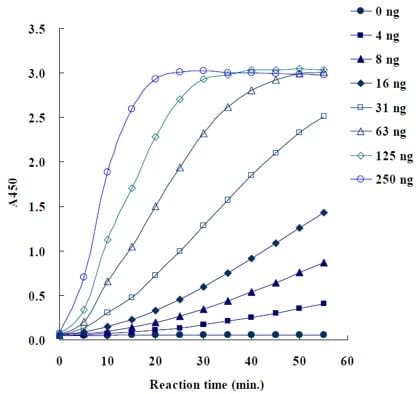NMNAT1 Activity Assay Kit (Colorimetric) (ab221820)
Key features and details
- Assay type: Semi-quantitative
- Detection method: Colorimetric
- Platform: Microplate reader
- Sample type: Cell Lysate, Purified protein
Overview
-
Product name
NMNAT1 Activity Assay Kit (Colorimetric) -
Detection method
Colorimetric -
Sample type
Cell Lysate, Purified protein -
Assay type
Semi-quantitative -
Species reactivity
Reacts with: Mammals -
Product overview
NMNAT1 Activity Assay Kit (Colorimetric) (ab221820) provides a sensitive and robust method to evaluate activators and inhibitors of nicotinamide mononucleotide adenylyltransferase (NMNAT) activity using recombinant NMNAT protein. The assay can also be used to measure activity from endogenous NMNAT immunoprecipitated from cell extracts. The assay is based on a multi-step reaction that converts WST-1 to WST-1 formazan, which can be easily detected at OD 450 nm. As the reaction is not stopped, it is necessary to monitor the absorbance increase of WST-1 formazan at OD450 nm at regular intervals after the reaction is initiated to determine velocity of reaction.
Detection of NMNAT activity can be measured with a One-Step or a Two-Step method. For the One-Step method, the four enzymes involved in the reaction are mixed together. The detection sensitivity of this method is lower than that of the Two-Step method since three coupled reactions occur simultaneously. We recommend performing the One-step assay only when using purified protein. The Two-Step method is performed by adding the first two enzymes to produce NAD+, followed by the addition of the rest of the components to form WST-1 formazan by NAD/NADH enzyme cycling reaction. We recommend performing the Two-Step assay if using immunoprecipitated cell lysates, as the assay procedure allows to check for contamination and interference for NAD+ present in the sample. Since the assay is based on a NAD+ detection system, it is not possible to directly detect NMNAT activity in crude cell extracts, which contain relatively high NAD+.
For the One-Step method, we describe a procedure to test NMNAT activity using purified enzyme and a separate procedure for screening NAMPT activity inhibitors. For the Two-Step Method, we describe two different procedures to test NMNAT activity using purified enzyme or to test immunoprecipitated cell lysates. There is also a separate procedure for screening NMNAT activity inhibitors.
-
Notes
Nicotinamide mononucleotide adenylyltransferase 1 (NMNAT1, EC 2.7.7.1) is a central enzyme in NAD+ biosynthesis, transferring the adenylyl moiety of ATP to β-Nicotinamide mononucleotide (NMN) or nicotinic acid mononucleotide (NaMN), resulting in the formation of NAD+ or NaAD and the release of pyrophosphate. This enzyme could be a potential target for therapeutical applications, because its activity is rather low in tumor cells. It has been shown that NMNAT1 can inhibit recombinant human poly(ADP-ribose) polymerase-1 (PARP-1) by about 35% and completely prevent the formation of branched ADP-ribose polymers.
-
Platform
Microplate reader
Properties
-
Storage instructions
Store at -80°C. Please refer to protocols. -
Components 100 tests ADH 1 x 500µl ATP 1 x 500µl Diaphorase 1 x 500µl EtOH Solution 1 x 500µl NMN 1 x 500µl NMNAT Assay Buffer (20X) 1 x 1ml NMNAT1 1 x 500µl WST-1 1 x 500µl -
Research areas
-
Function
Catalyzes the formation of NAD(+) from nicotinamide mononucleotide (NMN) and ATP (PubMed:17402747). Can also use the deamidated form; nicotinic acid mononucleotide (NaMN) as substrate with the same efficiency (PubMed:17402747). Can use triazofurin monophosphate (TrMP) as substrate (PubMed:17402747). Also catalyzes the reverse reaction, i.e. the pyrophosphorolytic cleavage of NAD(+) (PubMed:17402747). For the pyrophosphorolytic activity, prefers NAD(+) and NaAD as substrates and degrades NADH, nicotinic acid adenine dinucleotide phosphate (NHD) and nicotinamide guanine dinucleotide (NGD) less effectively (PubMed:17402747). Involved in the synthesis of ATP in the nucleus, together with PARP1, PARG and NUDT5 (PubMed:27257257). Nuclear ATP generation is required for extensive chromatin remodeling events that are energy-consuming (PubMed:27257257). Fails to cleave phosphorylated dinucleotides NADP(+), NADPH and NaADP(+) (PubMed:17402747). Protects against axonal degeneration following mechanical or toxic insults. -
Tissue specificity
Widely expressed with highest levels in skeletal muscle, heart and kidney. Also expressed in the liver pancreas and placenta. Widely expressed throughout the brain. -
Pathway
Cofactor biosynthesis; NAD(+) biosynthesis; NAD(+) from nicotinamide D-ribonucleotide: step 1/1.
Cofactor biosynthesis; NAD(+) biosynthesis; deamido-NAD(+) from nicotinate D-ribonucleotide: step 1/1. -
Involvement in disease
Leber congenital amaurosis 9 -
Sequence similarities
Belongs to the eukaryotic NMN adenylyltransferase family. -
Cellular localization
Nucleus. - Information by UniProt
-
Alternative names
- EC 2.7.7.1
- LCA9
- Leber's congenital amaurosis 9
see all
Images
-
 NMNAT1 Activity Assay Kit (Colorimetric) (ab221820) Measurement of NMNAT activity on immunoprecipitated cell lysates from Raji cell extracts
NMNAT1 Activity Assay Kit (Colorimetric) (ab221820) Measurement of NMNAT activity on immunoprecipitated cell lysates from Raji cell extractsNMNAT1 Activity Assay Kit (Colorimetric) (ab221820) Measurement of NMNAT activity on immunoprecipitated cell lysates from Raji cell extracts. Normal rabbit IgG control shows background activity compard to anti-NMNAT1 immunoprecipitate.
-
 NMNAT1 Activity Assay Kit (Colorimetric) (ab221820) Inhibitory effect of Gallotannin on recombinant NMNAT activity
NMNAT1 Activity Assay Kit (Colorimetric) (ab221820) Inhibitory effect of Gallotannin on recombinant NMNAT activityNMNAT1 Activity Assay Kit (Colorimetric) (ab221820). Inhibitory effect of Gallotannin on recombinant NMNAT activity using One-Step Assay Method
-
NMNAT1 Activity Assay Kit (Colorimetric) (ab221820) Time course kinetic curve of recombinant NMNAT activity using One-Step Assay Method









